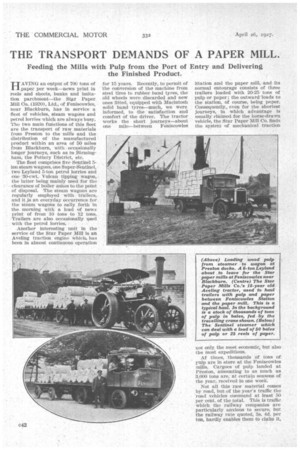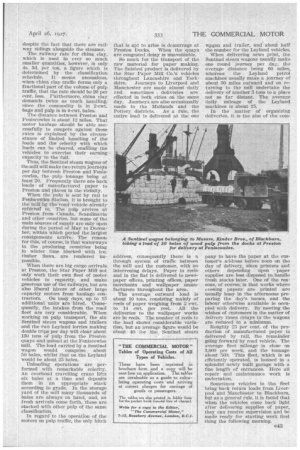THE TRANSPORT DEMANDS OF A PAPER MILL.
Page 64

Page 65

If you've noticed an error in this article please click here to report it so we can fix it.
Feeding the Mills with Pulp from the Port of Entry and Delivering the Finished Product.
HAVING an output of 700 tons of Ipaper per week—news print in reels and sheets, banks and imitation parchment—the Stgr Paper Mill Co. (1020), Ltd., of Feniscowles, near Blackburn, has in service a fleet of vehicles, steam wagons and petrol lorries which are always busy. The two main functions of this fleet are the transport of raw materials from Preston to the mills • and the distribution of the manufactured product within an area of 50 miles from Blackburn, with occasionally longer journeys, such as .to.Birmingham, the Pottery District, etc.
The fleet comprises five Sentinel 5ton steam wagons, one Super-Sentinel, two Leyland 5-ton petrol lorries and one -30-cwt. Vulcan tipping wagon, the latter being mainly used for the clearance of boiler ashes to the point of disposal. The steam wagons are regularly employed with trailers, and it is an everyday occurrence for the steam wagons to sally forth in themorning with ' a load of news print of from 10 tons to 12 tons. Trailers are also occasionally used with the petrol lorries.
-Another interesting unit in the service of the Star Paper Mill is an Aveling traction engine which, has been in almost continuous operation for 15 years. Recently, to permit of the conversion of the machine from steel tires to rubber band tyres, the old wheels were discarded and new ones fitted, equipped with Macintosh solid band. tyres—much, we were informed, to the satisfaction and comfort of the driver. The tractor works the short journeys—about one mile--between Feniscowles
Station and the paper mill, and its normal entourage consists of three trailers loaded with 20-25 tons of pulp or paper ; the outwardloads to the station, of course, being paper. Consequently,, even for the shortest journeys, in which advantage is usually claimed for the horse-drawn vehicle, the Star Paper Mill Co. finds the system of mechanical traction not only; the most economic, but also the most expeditious.
At times, thousands of tons of Pulp are in store at the Feniscowles mills. Cargoes of pulp landed at Pieston, amounting to as much as 3,000 tons are, • at certain seasons of the year, received in one week.
Not all this raw material comes by road, but of the year's traffic the road vehicles command at least 50 per cent. of the total. This is traffic which the railway companies are particularly anxious to secure, but ' the railway ratequoted, 5s. 4d. per ton, hardly enables them to claim it.
despite the fact that there are railway sidings alongside the steamer.
The ,railway rate for china clay, which is used in ever so much smaller quantities, however, is only 4s. 3d. per ton, a figure which is determined by the .classification schedule. It seems anomalous, when china clay traffic: forms only a fractional part of the volume of pulp traffic, that the rate should be 20 per cent. less. Furthermore, china clay demands twiceas much handling, since the commodity is in 2-cwt. hags and pulp is in 4-cwt. bales.
The distance between_ Preston and Peniscowles is about 12 miles. That motor haulage should be able successfully to compete against these rates is explained by the circumstance of limited handling of the loads and the celerity with which • loads can be cleared, enafiling the vehicles to exercise their earning capacity 'to the Thus, the Sentinel steam wagons of themill will make two return joerneya per day between Preston and Peniscowles, the pulp • tonnage being at least 20. Frequently there are back loads of manufactured paper to Preston and places in the vicinity.
When the pulp is sent by rail to Fertiscowles Station, it is brought to the mill by the road vehicle already ref erred to. The puk. arrives at Preston from Canada, Scandinavia _ and other countries, but Some of the Main sources of supply are only Open during the period of May to December, within which period the largest consignments artie. The reason for this, of coarse, is that Waterways in the producing countries being in winter time blocked with ice, timber flows. are rendered impossible.
When there are big cargo arrivals at Preston, the Star Paper Mill not only work their own fleet of motor vehicles to capacity, and make generous use of the railways, but are also liberal hirers of other large capacity motors from haulage contractors. On busy days, up to 15 additional units are hired. Consequently, the intakes from the road Sleet are very considerable. When working on pulp transport, the six Sentinel steam wagons and trailers and the two Leyland lorries making double trips per day will clear about 130 tons of pulp from the Preston quays and unload at the Feniscowles mill. The load carried by a Sentinel wagon would comprise about 50 bales, whilst that on the Leyland would he about 25 bales.
Unloading operations are performed with remarkable celerity. kn overhead travelling crane lifts six bales at a time and deposits them in an appropriate stack according to grade. in the storage yard of the mill many thousands of bales are always on hand, and as fresh arrivals come forth, these are stacked with other pulp of the same classification.
In regard to the operation of the motors on pulp traffic, the only hitch
that is apt to arise is demurr ge at Preston Docks. When the quays are congested delay is unavok4abie.
So much for the transport of the raw material for paper making. The finished product is delivered by the Star Paper Mill Co.'s vehicles throughout Lancashire and York-shire. journeys to Liverpool and Manchester are made almost .daily and sometimes deliveries are effected in both cities cii the same day. Journeys are also occasionally made to the Midlands and the
Pottery districts. As a rule, the entire load is delivered at the one address, consequently there is a through systetn of traffic between the mill and the customer, with no intervening delays. Paper in reels and in the flat is delivered to newspaper offices, printing offices, paper merchants and wallpaper manufacturers throughout the area.
The average outward load is about 10 tons, consisting mainly of reels of paper weighing from 2 cwt. to 14 cwt. per reel. All the deliveries to the wallpaper works are In reels. The number of reels to the load shows considerable variation; but an average figurewmild be about 40 for the. Sentinel steam
wagon and trailer, and about half the number for the Leyland vehicles.
When delivering news print, the Sentinel steam wagons usually make one round journey per day, the average distance being 60 miles, whereas he Leyland petrol machines usually make a journey of about 30 miles outward and on returning to the mill undertake the delivery of another 5 tons to a place not so far distant. The average daily mileage of the Leyland machines is about 75.
In the matter of organizing deliveries, it is the aim of the corn
pany to have the paper at the customer's address before noon on the day of delivery, since printers and others depending upon paper supplies are less disposed •to. handle fresh stocks later. One -of the reasons, of course, is that works where evening papers are printed . are usually busy in the afternoons preparing the day's issues, and the labour otherwise available is occupied with delivery. 13flueeting the wishes of customers in the matter of delivery times delays to' the wagons are reduced to a minimum.
Roughly 25 Per cent. of the production of manufactured paper is delivered by rail, the remainder going forward by road vehicle. The average fleet • mileage is close on 3,000. per week, and the tonnage ' about 500. 'This fleet, which is so efficiently operated, is hOused in a splendid newly built garage with a fine length of entrances. Here all -repair and maintenance work is undertaken.
Sometimes vehicles in the fleet • • •
bring back return loads from Liverpool and Manchester to Blackburn, but as a general rule, it is !wind that when the vehicles come back light .
after delivering supplies of paper, they can receive supervision and be made ready for starting work first thing the following morning.












































































































